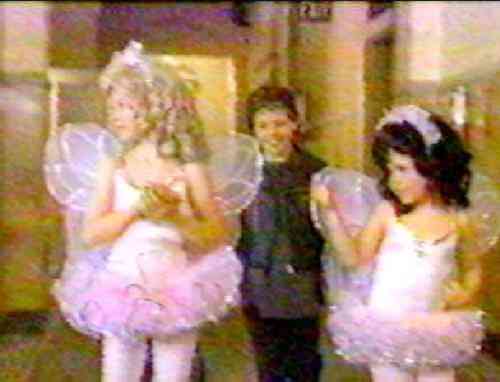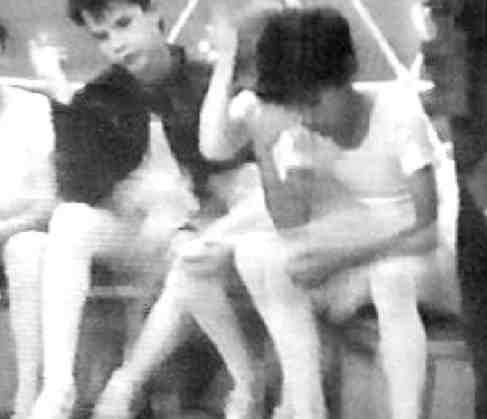
Boys' Ballet Costumes--Parodies

Figure 1.--Movies and televisions show often use boys in ballet costumes, often girls' costumes, for comedic parodies. This is especially common in America and Britain. This is a scene from the remake of the "Little Rascals" movie shorts into a 1999 feature film.
Alfalfa and Spanky are PRETENDING TO BE GIRLS (note the wigs) to get away from Butch
and "Woim"; so this is NOT a parody of male ballet dancers. Many American movie goers, however, find the fact that boys are wearing ballet costumes amusing.
|
Ballet costumes are commonly used in commedy parodies. The costumes are used to accentuate comedic situations by American an British writers. In these countries the popular culture strongly relates ballet and dance in general to girls. Thus boys dressed in ballet costumes are often perceived as humerous. The public reaction to these parodies appears to vary widely from country to country. HBC has less information on other countries such as Russia and France where ballet is more acceptable. Presumably boys in ballet costumes would be preceived as less humerous in these countries as ballet is more accepted in the popular culture. Interestingly, the comic device used is somtimes to outfit boys in girls ballet costumes like tutus--a garment a boy actually taking ballet would never wear. It is unclear to HBC why ballet is used as such a subject as parody. And why the parody often takes the step of outfitting boys in girls' costumes, something that would never occur in relaity.
Comedic Value
Ballet costumes are commonly used in commedy parodies. The costumes are used to accentuate comedic situations by American an British writers. In these countries the popular culture strongly relates ballet and dance in general to girls. Thus boys dressed in ballet costumes are often perceived as humerous. Ballet costumes also figure into other comedies that are not precisely parodies of ballet. What ever the precise plot line, American folm viewers find boys dressed in ballet costumes (both boys and girls' costumes) amusing.
Perhaps the comedic value comes from the mixed attitudes about boys doing ballet. There are cultural differences tht affect attitudes toward ballet. Negative attitudes are most pronounced in America and Britain, although HBC does not at this time understand why negative attitudes toward ballet are most pronounced in these two countries. Both parents and boys have concerns about doing ballet. These attitudes probably explain the comedic tension giving rise to parodies.
Chronology
HBC has little information at this time on when these parodies first begun. HBC remembers parodies of boys in ballet costumes and other inappriate clothes such as dresses in the Little Rascal movie shorts of the 1920s and 30s
Country Differences
The public reactiin to these parodies appears to vary widely from country to country. HBC has less information on other countries such as Russia and France where ballet is more acceptble. Presumably boys in ballet costumes would be preceived as less humerous in these countries as ballet is more accepted in the popular culture.
Reason
It is unclear to HBC why ballet is used as such a subject as parody. As a HBC contributor expains, "I think having a boy dress as a girl in ballet is so ridiculous that it seems funny to the producers and
their audience. How else could it be explained. Also, ballet has a connotation of being a sissy sport, so the girl outfits accentuates that aspect." Of course this is culturally based. Such parody does not occur in countries where ballet is more respected as an art form. It is not clear to HBC why ballet in America and Britain is subjected to such redicule.
Garments
Interestingly, the comic device used is generally to outfit boys in girls ballet costumes like tutus, a garment a boy taking ballet would never wear. Also unknown is why the parody often takes the step of outfitting boys in girls' costumes, something that would never occur in relaity.
Leotards
Boys wearing tights are often part of the parody used for comedic affect. In America, boys doing ballet more commonly wear "t" shirts and tights and less commonly leotards. Most of the parodies, however, show boys in leotards and tights.
Tights
In parodies, boys doing ballet are always depicted in tights. Normally white or other light-colored tights are selected. Tights are the most common garment for parody depictions.
Tu-tus
Perhaps more commonly used than just tights is also having the boy wear a tu-tu. What is difficult to understand is why the parody would be of something boys doing ballet would never do. Boys do war tights and keotards for ballet, but they of course never wear tu-tus.
Ballet slippers
Parodoes always show boys in ballet slippers, often black shoes with white or pink tights. Occasionally they are depicted in toe-shoes, even though toe shoes or mostly worn by girl dancers.
Programs
A variety of movies and television programs have used ballet costumes as a comedic device.
Little Rascals
This creation of the Hal Roach studio had several episodes touching upon clothing and Alfalfa, Spanky, and the other boys' embasrassment about clothing. In the original Rushin' Ballet episode, Butch and "Woim" DO dress in boys' ballet costumes and spin Alfalfa around and throw him on the floor. In the 1999 remake, the plot line has Alfalfa and Spanky pretending to be girls to disguise themselves. They are trying to get away from Butch and "Woim". Actually the boy playing Alfalfa had taken ballet and liked it. He was in fact a talented dancer and had to be coached to act awkward in his costume. As is common for such comedic episodes, the boys wear girls' tu-tus rather than boys' ballet outfits. This was even accentuated by wigs with ringlet curls, hair bows, and fairy wings.

Figure 2.--The Canadian television program, "You can't do that on television," often had the boys dress in ballet outfits, dresses, diappers, sailor sits, and other outfits for comedic affect.
|
This Canadian TV program produced in the 1980s was picked up by American cable networks, especially Nickolonian. Many episodes included clothing. Often skits were built around the boys being dresses in dresses, kiklts, sailor suits, Fauntleroy suits, diappers, and other outfits boys might find enbarassing. I think some of the skits were thought up by the boys themselves. Interestingly the skits involving the girls rarely touched upon clothing. Sometimes the boys appeared in tights and tu-tus. I'm not sure just why other than for comic relief.
Christopher Wagner

Navigate the Historic Boys' Clothing Web Site:
[Introduction]
[Activities]
[Bibliographies]
[Biographies]
[Chronologies]
[Contributions]
[Countries]
[Frequently Asked Questions]
[Style Index]
[Boys' Clothing Home]
Navigate the Historic Boys' Clothing Web dance pages:
[Return to the Main ballet dance page]
[Ballet]
[Irish step]
[Kilts]
[Highland]
[Ballroom]
[Native American]
[Tap]
Created: Juky 27, 2000
Last updated: August 29, 2000




